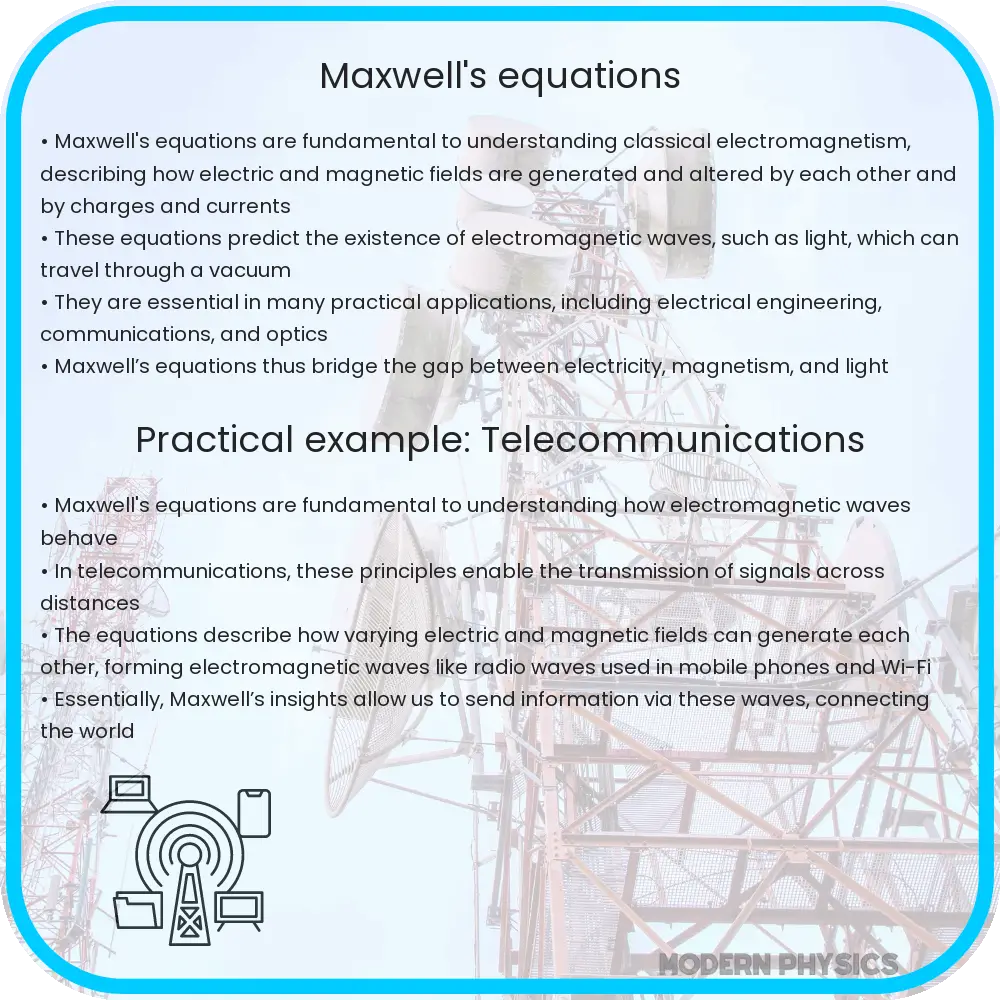Explore Maxwell’s Equations: Unveiling the core concepts, vast applications, and insights of electromagnetism in modern technology and physics.

Maxwell’s Equations: The Foundation of Electromagnetism
In the world of physics, few sets of equations have been as influential as Maxwell’s Equations. Formulated by James Clerk Maxwell in the mid-19th century, these equations describe the fundamental principles of electromagnetism, a branch of physics concerning the electromagnetic force that causes interactions between electrically charged particles. In this article, we explore the core concepts, applications, and profound insights offered by Maxwell’s Equations.
Core Concepts of Maxwell’s Equations
Maxwell’s Equations consist of four partial differential equations. Each equation serves as a cornerstone in understanding electromagnetic phenomena:
- Gauss’s Law for Electricity: \[ \nabla \cdot \mathbf{E} = \frac{\rho}{\varepsilon_0} \] This equation illustrates how electric charges produce an electric field. The divergence of the electric field, \(\mathbf{E}\), is proportional to the charge density, \(\rho\), in a region of space.
- Gauss’s Law for Magnetism: \[ \nabla \cdot \mathbf{B} = 0 \] This law indicates that there are no ‘magnetic charges’ analogous to electric charges and that magnetic field lines form closed loops.
- Faraday’s Law of Induction: \[ \nabla \times \mathbf{E} = -\frac{\partial \mathbf{B}}{\partial t} \] This equation describes how a time-varying magnetic field creates an electric field. This is the principle behind the operation of electric generators and transformers.
- Ampère’s Law with Maxwell’s Addition: \[ \nabla \times \mathbf{B} = \mu_0 \mathbf{J} + \mu_0 \varepsilon_0 \frac{\partial \mathbf{E}}{\partial t} \] This shows that magnetic fields are generated by electric currents and changing electric fields, laying the groundwork for understanding electromagnetic waves.
Applications of Maxwell’s Equations
The applications of Maxwell’s Equations are vast and have profoundly influenced modern technology and theoretical physics. They underpin the design and functioning of a wide array of devices from everyday electronics like radio, television, and mobile phones, to more sophisticated systems like radar and satellite communications. Additionally, these equations play a critical role in understanding and designing electrical and magnetic materials, circuits, and much more.
Maxwell’s Equations are not just limited to practical applications; they are also essential in theoretical physics. They provided the first unified theory of electricity and magnetism, leading to the concept of the electromagnetic field. This concept is pivotal in the further development of physics, including the Special Theory of Relativity by Albert Einstein.
Insights from Maxwell’s Equations
The theoretical implications of Maxwell’s Equations extend far beyond their practical applications. These equations were among the first to suggest the unification of different forces of nature, an idea that has been central to modern physics. They implied that light is an electromagnetic wave, a revelation that has expanded our understanding of the electromagnetic spectrum, including radio waves, microwaves, infrared, visible light, ultraviolet, X-rays, and gamma rays.
Moreover, Maxwell’s Equations have been fundamental in the development of quantum mechanics and quantum electrodynamics. The concept of fields emanating from these equations has been integral in understanding particle physics, leading to breakthroughs in how we understand the fundamental constituents of matter and the forces acting upon them.
Continuing Relevance of Maxwell’s Equations
In the 21st century, Maxwell’s Equations continue to be a subject of study and research. They play a crucial role in the ongoing exploration of electromagnetism at both macroscopic and microscopic levels. As technology evolves, especially in the field of wireless communication and advanced materials, the relevance of these equations remains strong, driving innovation and discovery.
Furthermore, Maxwell’s Equations are a staple in the education of physics and engineering students worldwide. They not only provide a foundation for understanding electromagnetism but also offer a window into the mathematical beauty and symmetry in physical laws.
Conclusion
Maxwell’s Equations, more than a century after their formulation, continue to be one of the most elegant and powerful sets of equations in physics. Their ability to describe the electromagnetic phenomena that underpin much of our modern technological world is unparalleled. From enabling the development of countless devices and technologies to providing deep insights into the nature of the universe, these equations remain a testament to human ingenuity and the quest for understanding the fundamental forces of nature. They embody not only the unification of electricity and magnetism but also symbolize the ongoing pursuit of unifying all fundamental forces in physics, a pursuit that continues to inspire and challenge scientists and researchers around the world.
